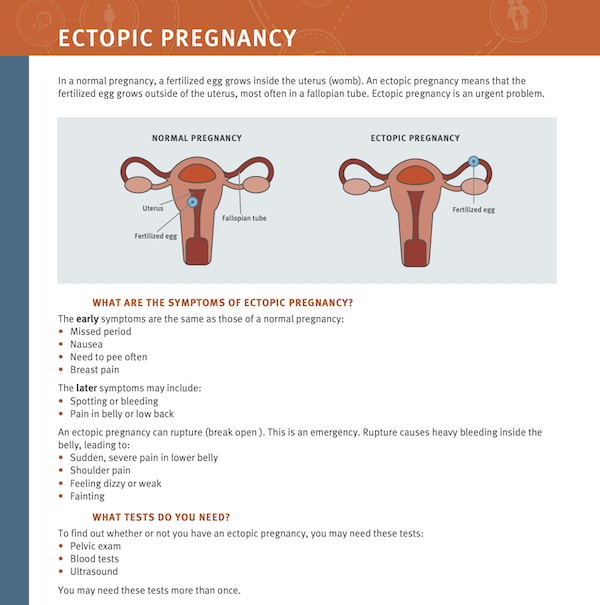
Ectopic Pregnancy: A Comprehensive Guide to Diagnosis and Treatment
Introduction
An ectopic pregnancy occurs when a fertilized egg implants outside the uterus, typically in the fallopian tube. This condition is potentially life-threatening and requires prompt medical attention. Understanding the causes, symptoms, and treatment options for ectopic pregnancy is crucial for ensuring the well-being of women.
Causes of Ectopic Pregnancy
The exact cause of ectopic pregnancy is often unknown. However, certain factors increase the risk of developing this condition, including:
- Previous ectopic pregnancy
- Pelvic inflammatory disease (PID)
- Endometriosis
- Use of intrauterine devices (IUDs)
- Smoking
- Infertility treatments
Symptoms of Ectopic Pregnancy
The symptoms of ectopic pregnancy can vary depending on the location of the implantation. Common signs include:
- Pelvic pain, often on one side
- Irregular vaginal bleeding
- Nausea and vomiting
- Abdominal tenderness
- Shoulder pain (if the pregnancy is in the fallopian tube and has ruptured)
Diagnosis of Ectopic Pregnancy
Early diagnosis of ectopic pregnancy is essential to prevent life-threatening complications. Diagnosis involves:
- Medical history: The doctor will inquire about the patient’s symptoms and risk factors.
- Physical examination: The doctor will perform a pelvic exam to check for tenderness or a mass.
- Transvaginal ultrasound: This imaging test uses sound waves to create images of the uterus and fallopian tubes, helping to identify an ectopic pregnancy.
- Blood tests: Measuring hormone levels, such as human chorionic gonadotropin (hCG), can help confirm the pregnancy and determine its location.
Treatment of Ectopic Pregnancy
Treatment for ectopic pregnancy depends on the patient’s condition and the location of the implantation. The two main treatment options are:
1. Medication (Methotrexate)
Methotrexate is a medication that stops the growth of the ectopic pregnancy. It is used when the pregnancy is small and there is no evidence of rupture. The medication is injected into the muscle or given as a pill.
2. Surgery (Laparoscopy or Salpingectomy)
Laparoscopy is a minimally invasive surgical procedure that involves making small incisions in the abdomen and inserting a laparoscope, a thin tube with a camera, to visualize the ectopic pregnancy. The pregnancy can then be removed or the fallopian tube containing the pregnancy can be removed (salpingectomy).
Complications of Ectopic Pregnancy
If left untreated, an ectopic pregnancy can lead to serious complications, including:
- Tubal rupture: The fallopian tube can rupture, causing internal bleeding and life-threatening shock.
- Hemorrhage: Severe bleeding can occur if the ectopic pregnancy ruptures or if it implants in a blood vessel.
- Infection: An ectopic pregnancy can become infected, leading to sepsis.
- Infertility: Damage to the fallopian tube can reduce fertility or increase the risk of future ectopic pregnancies.
Prevention of Ectopic Pregnancy
While not all ectopic pregnancies can be prevented, certain measures can reduce the risk:
- Avoiding smoking
- Practicing safe sex to prevent pelvic inflammatory disease
- Using contraception to prevent unintended pregnancies
- Seeking medical attention promptly if experiencing pelvic pain or irregular vaginal bleeding
Recovery from Ectopic Pregnancy
Recovery from ectopic pregnancy varies depending on the treatment method. After medication treatment, patients may experience vaginal bleeding and cramping for several weeks. After surgery, recovery time is typically longer, and patients may experience abdominal pain and tenderness.
Emotional recovery from ectopic pregnancy is also important. Patients may experience feelings of grief, loss, and anxiety. Seeking support from family, friends, or a therapist can help with the emotional healing process.
Conclusion
Ectopic pregnancy is a serious medical condition that requires prompt diagnosis and treatment. Understanding the causes, symptoms, and treatment options is crucial for ensuring the well-being of women. By recognizing the signs and seeking medical attention early, women can reduce the risk of life-threatening complications and improve their chances of future pregnancies.